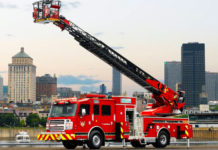In response to increased gun violence and mass casualty events in the country, the White House and the Department of Homeland Security created “Stop the Bleed,” a national campaign to help improve survival from life-threatening bleeding.
In the wake of a traumatic event, uncontrolled bleeding is one of the most frequent causes of death.
A person can bleed to death in less than five minutes, which makes it difficult for emergency medical responders to arrive fast enough to control bleeding and save lives.
(The cast of ‘Code Black’ and CBS Cares encourage you to learn how to stop the bleed. Courtesy of CBS and YouTube)
The general public wants to learn bleeding control techniques.
Many civilians have expressed interest in taking a bleeding control training course that would empower them to immediately assist victims of active shooter and other intentional mass casualty events at the point of wounding, according to results of a new national poll published in the Journal of the American College of Surgeons.
Furthermore, the vast majority of civilians support training and equipping police officers to perform severe bleeding control on victims as soon as possible rather than wait for emergency medical services (EMS) personnel to arrive on the scene.
There’s also strong public support for putting bleeding control kits in public places where large crowds gather, similar to the way that automatic external defibrillators are now found in airports and shopping malls for use by responders who have undergone cardiopulmonary resuscitation training.

In addition to training law enforcement officers in bleeding control and instantly providing them with equipment to do so, emergency medical service personnel also need quicker access to the wounded.
However, another key element calls for using civilian bystanders as immediate responders who perform external bleeding control for victims at the point of wounding before the arrival of professional responders.
This element from the Hartford Consensus is at the core of the “Stop the Bleed” campaign by the Department of Homeland Security through the National Security Council.
(In the nation’s largest Stop the Bleed initiative, UPMC is partnering with the Copeland Regional Trauma Council, a consortium of trauma centers in Pennsylvania, Ohio and West Virginia, to coordinate Stop the Bleed efforts. Courtesy of the University of Pittsburgh Medical Center and YouTube)
A Perfect Stranger
“A Perfect Stranger” tells the story of Kinneil and Angelia and the event that brought the two women together.
It is a powerful reminder that at a moment’s notice, any one of us might find ourselves in a situation where we are the help until help arrives.
In the end, this film calls on all Americans to remake what it means to be a bystander.
(Video courtesy of FEMA and YouTube)
Stop the Bleeding Now – What YOU Can Do

Call 9-1-1
- Call 9-1-1 yourself – OR – Tell someone to call 9-1-1
Ensure Your Safety
- Before you offer any help, you must ensure your own safety!
- If you become injured, you will not be able to help the victim.
- Provide care to the injured person if the scene is safe for you to do so.
- If, at any time, your safety is threatened, attempt to remove yourself (and the victim if possible) from danger and find a safe location.
- Protect yourself from blood-borne infections by wearing gloves, if available.
Look for Life-Threatening Bleeding
- Find the source of bleeding
- Open or remove the clothing over the wound so you can clearly see it. By removing clothing, you will be able to see injuries that may have been hidden or covered.
- Look for and identify “life-threatening” bleeding. Examples include:
- Blood that is spurting out of the wound.
- Blood that won’t stop coming out of the wound.
- Blood that is pooling on the ground.
- Clothing that is soaked with blood.
- Bandages that are soaked with blood.
- Loss of all or part of an arm or leg.
- Bleeding in a victim who is now confused or unconscious.
Compress and Control
Key Point
There are a number of methods that can be used to stop bleeding and they all have one thing in common—compressing a bleeding blood vessel in order to stop the bleeding.
If you don’t have a trauma first aid kit:

- Take any clean cloth (for example, a shirt) and cover the wound.
- If the wound is large and deep, try to “stuff” the cloth down into the wound.
- Apply continuous pressure with both hands directly on top of the bleeding wound.
- Push down as hard as you can.
- Hold pressure to stop bleeding. Continue pressure until relieved by medical responders.
If you do have a trauma first aid kit:
For life-threatening bleeding from an arm or leg and a tourniquet is NOT available OR for bleeding from the neck, shoulder or groin:
- Pack (stuff) the wound with a bleeding control (also called a hemostatic) gauze, plain gauze, or a clean cloth and then apply pressure with both hands
- Open the clothing over the bleeding wound. (A)
- Wipe away any pooled blood.
- Pack (stuff) the wound with bleeding control gauze (preferred), plain gauze, or clean cloth. (B)
- Apply steady pressure with both hands directly on top of the bleeding wound. (C)
- Push down as hard as you can.
- Hold pressure to stop bleeding. Continue pressure until relieved by medical responders.
For life-threatening bleeding from an arm or leg and a tourniquet is available:
- Apply the tourniquet
- Wrap the tourniquet around the bleeding arm or leg about 2 to 3 inches above the bleeding site (be sure NOT to place the tourniquet onto a joint—go above the joint if necessary).
- Pull the free end of the tourniquet to make it as tight as possible and secure the free end. (A)
- Twist or wind the windlass until bleeding stops. (B)
- Secure the windlass to keep the tourniquet tight. (C)
- Note the time the tourniquet was applied. (D)
Note: A tourniquet will cause pain but it is necessary to stop life-threatening bleeding.
Instructions and photos have been taken from the Save a Life booklet. Download the booklet for additional information on how to stop the bleed.
(Full Credit and Courtesy of Pons PT, Jacobs L. Save a life: What everyone should know to stop bleeding after an injury. Chicago, IL: American College of Surgeons; 2016.)
Download the booklet
(With first responders en route, you could help save lives. Courtesy of WIVBTV and YouTube)

– Lenworth M. Jacobs, Jr., MD, FACS, Chairman, Hartford Consensus
Learn more…
- The Hartford Consensus: A National Survey of the Public Regarding Bleeding Control
- Most Civilians Support Wider Access to Training and Equipment to Stop Severe Bleeding in Victims of Active Shooter and Other Mass Casualty Events
- Greater Public Access to Bleeding Control Training and Kits Receives Strong Support within the U.S. Medical Community
Original post http://www.bleedingcontrol.org/public and http://www.bleedingcontrol.org/public/stop-the-bleed-now




















